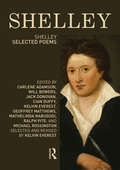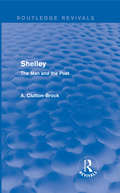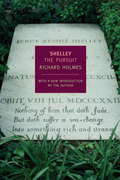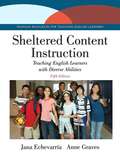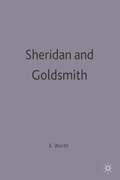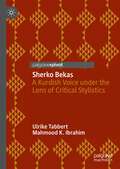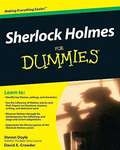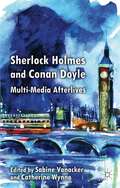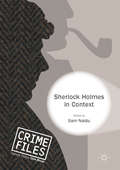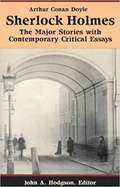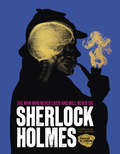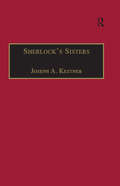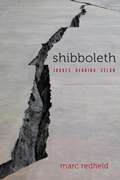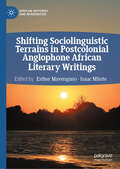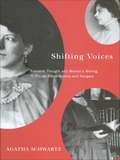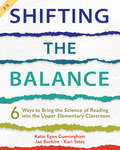- Table View
- List View
Shelley: Selected Poems (Longman Annotated English Poets)
by Jack Donovan Geoffrey Matthews Will Bowers Cian Duffy Kelvin Everest Michael Rossington Ralph Pite Carlene Adamson Mathelinda NabugodiPercy Bysshe Shelley (1792–1822) was one of the major Romantic poets and wrote what is critically recognised as some of the finest lyric poetry in the English Language. In this volume, the editors have selected the most popular, significant and frequently taught poems from the six-volume Longman Annotated edition of Shelley’s poems. Each poem is fully annotated, explained and contextualised, along with a comprehensive list of abbreviations, an inclusive bibliography of material relating to the text and interpretation of Shelley’s poetry, plus an extensive chronology of Shelley’s life and works. Headnotes and footnotes furnish the personal, literary, historical and scientific information necessary for an informed reading of Shelley’s richly varied and densely allusive verse, making this an ideal anthology for students, classroom use, and anyone approaching Shelley’s poetry for the first time; however the level and extent of commentary and annotation will also be of great value for researchers and critics.
Shelley: The Man and the Poet (Routledge Revivals)
by A. Clutton-BrockFirst published in 1909, with a second edition in 1923, this concise and easily accessible overview of Shelley’s life and work presents the poet not as popular legend would have it, but in a more objective light. A.Clutton-Brock notes his forthright and imperious attitude to life – a life in which Shelley found himself increasingly unhappy – and critically examines many facets of his artistic career which are often overlooked or misrepresented.
Shelley: The Pursuit
by Richard HolmesShelley: The Pursuit is a most apt title as this is indeed a biography that goes on the chase to bring together all manner of opinions; both contemporary and historical to weave together the short chaotic life of the poet Percy Bysshe Shelley.
Shelley’s Poetics of Reticence: Shelley’s Shame (Routledge Studies in Romanticism #1)
by Merrilees RobertsExploring the rhetorical and phenomenological links between shame and reticence, this book examines the psychology of Shelley’s anguished poet-Subject. Shelley’s struggles with the fragility of the ‘self’ have largely been seen as the result of thinking which connects emotional hyperstimulation to moral and political undermining of the individual ‘will’. This work takes a different approach, suggesting that Shelley’s insecurities stemmed from anxieties about the nature of aesthetic self-representation. Shame is an appropriate affective marker of such anxiety because it occurs at the cusp between internal and external self-evaluation. Shelley’s reticent poetics transfers an affective sense of shame to the reader and provokes interpretive responsibility. Paying attention to the affective contours of texts, this book presents new readings of Shelley’s major works. These interpretations show that awakening the reader’s ethical discretion creates a constructive dynamic which challenges influential deconstructive readings of the unfinished nature of Shelley’s work and thought.
Sheltered Content Instruction: Teaching English Learners With Diverse Abilities (Fifth Edition)
by Jana Echevarria Anne GravesA popular text by renowned authors Jana Echevarria and Anne Graves, Sheltered Content Instruction: Teaching English Learners with Diverse Abilities , 5/e presents a complete guide to preparing teachers to use the sheltered instruction approach to deliver content area instruction to English learners. It includes recent research, best practices, and policies that impact the education of English learners, and gives teachers the means to think about their own educational practices and the issues they should consider when teaching English learners, especially those struggling academically.
Shemushi Dviteeyo Bhag class 10 - Himachal Pradesh Board: शेमुषी द्वितीयो भागः कक्षा १० - हिमाचल प्रदेश बोर्ड
by Himachal Pradesh Board of School Education - Dharamshalaसंस्कृत के नवीन पाठ्यक्रम में निर्धारित लक्ष्यों के अनुरूप नवम कक्षा के लिए शेमुषी प्रथम भाग नामक पाठ्यपुस्तक के अनंतर दशम कक्षा के लिए यह शेमुषी द्वितीय भाग पुनरीक्षित संस्करण (2017) प्रस्तुत किया जा रहा है। इस संकलन में संस्कृत को जीवन्त भाषा के रूप में देखा गया है जिसकी धारा निरन्तर प्रवाहित होती रही है। इसीलिए इसमें आधुनिक संस्कृत रचनाओं के समावेश के साथ अन्य भाषाओं के साहित्य से अनूदित पाठों को भी ग्रहण किया गया है। पाठों के आरम्भ में पाठ-सन्दर्भ दिए गए हैं जिनसे पाठ-प्रसंगों को समझा जा सके। छात्रों को सीखने का अधिकाधिक अवसर मिल सके इसलिए पाठों के अन्त में विविध अभ्यासों वाली प्रश्नावली दी गयी है। छात्र पाठों को स्वयमेव समझ सकें इसके लिए ‘शब्दार्थाः’ शीर्षक के अन्तर्गत पाठ में आए नवीन तथा कठिन शब्दों के संस्कृत तथा हिंदी में अर्थ दिए गए हैं। ‘योग्यता-विस्तार’ के अन्तर्गत ऐसी सामग्री दी गई है जिससे छात्र ज्ञान के अग्रिम चरण की ओर सहज उन्मुख हो सकें। अध्यापकों के लिए पर्याप्त शिक्षण-संकेत दिए गए हैं ताकि निर्धारित पाठ्य बिंदुओं को ध्यान में रखकर अध्यापन कर सकें। पाठों को दृश्य विधि से स्पष्ट करने के लिए विषयानुकूल चित्र भी दिए गए हैं। इस पुस्तक में कुल 12 पाठ रखे गए हैं। इनमें सात पाठ प्राचीन ग्रन्थों से तथा पाँच पाठ आधुनिक मौलिक अथवा अनूदित संस्कृत रचनाओं से लिए गए हैं।
Shemushi Prathmo Bhag class 9 - Himachal Pradesh Board: शेमुषी द्वितीयो भागः कक्षा ९ - हिमाचल प्रदेश बोर्ड
by Himachal Pradesh Board of School Education - Dharamshalaसंस्कृत के नवीन पाठ्यक्रम में निर्धारित लक्ष्यों के अनुरूप नवम कक्षा के लिए शेमुषी (प्रथमो भागः) नामक पाठ्यपुस्तक का प्रणयन किया गया है। नवीन पाठ्यक्रम एवं वर्तमान पुस्तक की विशिष्टताओं में सर्वप्रथम उल्लेखनीय है कि इसमें संस्कृत को एक जीवन्त भाषा के रूप में देखा गया है जिसकी धारा निरन्तर प्रवाहित होती रही है। इसी दृष्टि से इसमें आधुनिक संस्कृत रचनाओं के समावेश के साथ ही साथ अन्य भाषाओं के साहित्य से अनूदित रचनाओं को भी ग्रहण किया गया है। पाठों के आरंभ में पाठ-संदर्भ दिये गये हैं, जिनसे छात्र पाठ-प्रसंग को सरलता से समझ सकेंगे। छात्रों को सीखने के अधिकाधिक अवसर देने के लिए पाठों के अन्त में विविध-प्रश्नों वाली अभ्यासचारिका दी गयी है। छात्र पाठों को स्वयमेव समझ सकें इसके लिए 'शब्दार्थाः' शीर्षक के अन्तर्गत पाठ में आये सभी नवीन तथा कठिन शब्दों के संस्कृत, हिन्दी तथा अंग्रेजी में अर्थ दिये गये हैं। योग्यता-विस्तार के अन्तर्गत ऐसी सामग्री दी गयी है, जिससे छात्र ज्ञान के अग्रिम चरण की ओर सहज ही उन्मुख हो सकें। अध्यापकों के लिए यथेष्ट रूप से शिक्षण-संकेत भी दिये गये हैं ताकि निर्धारित पाठ्यबिन्दुओं को ध्यान में रखते हुए अध्यापन किया जा सके। पाठों को दृश्य-विधि से स्पष्ट करने के लिए विषयानुकूल चित्रों का समावेश करके पुस्तक को आकर्षक बनाया गया है। इस पुस्तक में कुल 12 पाठ रखे गये हैं जिनमें छह पाठ प्राचीन ग्रन्थों से तथा छह पाठ आधुनिक रचनाओं से हैं। आधुनिक पाठों में भी चार पाठ संस्कृत की मौलिक रचनाओं तथा दो पाठ दूसरी भाषाओं से अनुवाद के रूप में हैं।
Sheridan And Goldsmith (English Dramatists)
by Katharine WorthEach generation needs to be introduced to the culture and great works of the past and to reinterpret them in its own ways. This series re-examines the important English dramatists of earlier centuries in the light of new information, ew interests and new attitudes. The books will be relevant to those interested in literatire, theatre and cultural history, and to threatre-goers and general readers who want an up-to-date view of these dramatists and their plays, with the emphasis on performance and relevant culture history. This book explores the reasons for the deep and lasting appeal of Sheridan's and Goldsmith's comedies, showing how they operate at the profound imaginative level and draw on their author's experience as Irish wits in an English scene. Their subtle dramatic techniques are examined in relation to physical features of the eighteenth-century stage. A chapter on sentimental comedy relates to plays such as Hugh Kelly's False Delicacy to the balance of irony and sentiment in Goldsmith's The Good Natur'd Man and Sheridan's A Trip to Scarborough. The continuing freshness of the comedy of mistakes, masks and Harlequin-like role playing which the two playwrights draw from the operatic and theatrical conventions of their day is illustrated from modern productions. These have helped to illuminate the psychological truth and social awareness underlying the sparkling surfaces of Sheridan's and Goldsmith's classic comedies.
Sherko Bekas: A Kurdish Voice under the Lens of Critical Stylistics
by Ulrike Tabbert Mahmood K. IbrahimThis book explores poetry by Sherko Bekas, a Kurdish writer and Swedish Tucholsky award winner, providing contextualising biography (with original new information from an interview with his son) and critical stylistic analyses of two selected poems. The authors also include a section on the Kurdish language and translation of the poems into English. There are very few English translations of some of Bekas' poems and no book so far on the stylistic or even linguistic analysis of his work, with the result that Bekas is not widely known in the "Western" world. This book aims to fill this lacuna in the literary and linguistic canon, and it will be of interest to students and scholars of Translation, Stylistics, Middle Eastern History and Literature.
Sherlock Holmes For Dummies
by David A. Crowder Steven DoyleGet a comprehensive guide to this important literary figure and his author. A classic literary character, Sherlock Holmes has fascinated readers for decades -- from his repartee with Dr. Watson and his unparalleled powers of deduction to the settings, themes, and villains of the stories. Now, this friendly guide offers a clear introduction to this beloved figure and his author, Sir Arthur Conan Doyle, presenting new insight into the detective stories and crime scene analysis that have has made Sherlock Holmes famous. Inside you'll find easy-to-understand yet thorough information on the characters, recurring themes, and locations, and social context of the Sherlock Holmes stories, the relationship of these stories to literature, and the forensics and detective work they feature. You'll also learn about the life of the author. Better understand and enjoy this influential literary character with this plain-English guide. Gain insight on these classic Doyle tales -- from the classic Hound of the Baskervilles to the lesser-known short stories to Holmes stories written by other mystery writers. Explore the appearance of Sherlock Holmes on film, TV, and stage. Examine Holmes today -- from the ever-expanding network of fans worldwide to story locations that fans can visit. It's elementary! Sherlock Holmes For Dummies is an indispensable guide for students and fans alike!
Sherlock Holmes and Conan Doyle
by Sabine Vanacker Catherine WynneSherlock Holmes is an iconic figure within cultural narratives. More recently, Conan Doyle has also appeared as a fictional figure in contemporary novels and films, confusing the boundaries between fiction and reality. This collection investigates how Holmes and Doyle have gripped the public imagination to become central figures of modernity.
Sherlock Holmes from Screen to Stage
by Benjamin PooreThis book investigates the development of Sherlock Holmes adaptations in British theatre since the turn of the millennium. Sherlock Holmes has become a cultural phenomenon all over again in the twenty-first century, as a result of the television series Sherlock and Elementary, and films like Mr Holmes and the Guy Ritchie franchise starring Robert Downey Jr. In the light of these new interpretations, British theatre has produced timely and topical responses to developments in the screen Sherlocks' stories. Moreover, stage Sherlocks of the last three decades have often anticipated the knowing, metafictional tropes employed by screen adaptations. This study traces the recent history of Sherlock Holmes in the theatre, about which very little has been written for an academic readership. It argues that the world of Sherlock Holmes is conveyed in theatre by a variety of games that activate new modes of audience engagement.
Sherlock Holmes in Context
by Sam NaiduThis book of interdisciplinary essays serves to situate the original Sherlock Holmes, and his various adaptations, in a contemporary cultural context. This collection is prompted by three main and related questions: firstly, why is Sherlock Holmes such an enduring and ubiquitous cultural icon; secondly, why is it that Sherlock Holmes, nearly 130 years after his birth, is enjoying such a spectacular renaissance; and, thirdly, what sort of communities, imagined or otherwise, have arisen around this figure since the most recent resurrections of Sherlock Holmes by popular media? Covering various media and genres (TV, film, literature, theatre) and scholarly approaches, this comprehensive collection offers cogent answers to these questions.
Sherlock Holmes in Portrait and Profile
by Walter KlinefelterCurrently, no doubt, the picture of Sherlock Holmes in most peoples minds is that of Basil Rathbone but that was not always so The evolution of that famous profile in the deerstalker cap, smoking a curved pipe, is a story in itself This picture account of Holmes' illustrators traces the history of Holmesian portraiture in England and the United States over a period of nearly sixty years. Not every illustrator saw Holmes as Dr Watson described him. In height he was rather over six feet, and so excessively lean that he seemed to be considerably taller. His eyes were sharp and piercing and his thin, hawk-like nose gave his whole expression an alertness and decision. In spite of this authoritative description, Holmes' first illustrator, D H Friston, portrayed him in 1887 as gaudily dressed, side whiskered dandy Even more heretical were the crude sketches by Charles Doyle published in 1888 His most famous English illustrator, Sidney Paget, started to picture Holmes as we know him Frederick Dorr Steele's drawings of Holmes span almost forty years, from a series in Colliers Weekly in 1903 to an advertisement for Basil Rathbone's Hound of the Baskervilles in 1939. Both scholarship and devotion have produced this treasure trove of 65 illustrations and the story-by story-account that accompanies them As Vincent Starret says, scholarship aside, it is a fascinating research that admirers of the Master on all levels will hail with satisfaction. Walter Klinefelter, a long time devotee of Holmes and stalwart Baker Street Irregular, is the author of many books including Ex Libris A Conon Doyle: Sherlock Holmes.
Sherlock Holmes: The Major Stories with Contemporary Critical Essays
by Arthur Conan Doyle John A. HodgsonContaining fifteen Sherlock Holmes stories, this volume of Sherlock Holmes features concise commentary on how each story relates to the author, the series, and the detective genre as well as nine accompanying essays which reflect the recent critical interest in Holmes and examine the stories from a variety of contemporary critical perspectives.
Sherlock Holmes: The Man Who Never Lived And Will Never Die
by OtherEver since his creation, Sherlock Holmes has enthralled readers. Our perception of him and his faithful companion, Dr Watson, has been shaped by a long line of film, TV and theatre adaptations. This richly illustrated book, compiled by Alex Werner, Head of History Collections at the Museum of London, is an essential guide to the great fictional detective and his world. Using the museum's unrivalled collections of photographs, paintings and original artefacts, it illuminates the capital city that inspired the Sherlock Holmes stories, in particular its fogs, Hansom cabs, criminal underworld, famous landmarks and streets. Accompanying the landmark exhibition at the Museum of London, the first since 1951, this book explores how Arthur Conan Doyle's creation of Sherlock Holmes has transcended literature and continues to attract audiences to this day. Authoritatively written by leading experts, headed by Sir David Cannadine, this thought-provoking companion sheds new light on the famous sleuth and reveals the truth behind the fiction, over 125 years after the first Sherlock Holmes story was written.
Sherlock's Sisters: The British Female Detective, 1864-1913 (The Nineteenth Century Series)
by Joseph A. KestnerSherlock's Sisters: The British Female Detective, 1864-1913 examines the fictional female detective in Victorian and Edwardian literature. This character, originating in the 1860s, configures a new representation of women in narratives of the nineteenth and twentieth centuries. This analysis explores female empowerment through professional unofficial or official detection, especially as this surveillance illuminates legal, moral, gendered, institutional, criminal, punitive, judicial, political, and familial practices. This book considers a range of literary texts by both female and male writers which concentrate on detection by women, particularly those which followed the creation of Sherlock Holmes by Arthur Conan Doyle in 1887. Cultural movements, such as the emergence of the New Woman, property law or suffragism, are stressed in the exploits of these resourceful investigators. These daring women deal with a range of crimes, including murder, blackmail, terrorism, forgery, theft, sexual harassment, embezzlement, fraud, impersonation and domestic violence. Privileging the exercise of reason rather than intuition, these women detectives are proto-feminist in their demonstration of women's independence. Instead of being under the law, these women transform it. Their investigations are given particular edge because many of the perpetrators of these crimes are women. Sherlock's Sisters probes many texts which, because of their rarity, have been under-researched. Writers such as Beatrice Heron-Maxwell, Emmuska Orczy, L.T. Meade, Catherine Pirkis, Fergus Hume, Grant Allen, Leonard Merrick, Marie Belloc Lowndes, George Sims, McDonnell Bodkin and Richard Marsh are here incorporated into the canon of Victorian and Edwardian literature, many for the first time. A writer such as Mary Elizabeth Braddon is reassessed through a neglected novel. The book includes works by Irish and Australian writers to present an inclusive array of British texts. Sherlock's Sisters enlarges the perception of emerging female empowerment during the nineteenth century, filling an important gap in the fields of Gender Studies, Law/Literature and Popular Culture.
She’s In CTRL: How women can take back tech – to communicate, investigate, problem-solve, broker deals and protect themselves in a digital world
by Anne-Marie Imafidon'A practical and positive guide to using tech to change women's lives for the better' -Caroline Criado Perez, author of Invisible Women: exposing data bias in a world designed for men'A powerful and inspiring call to action from one of Britain's brightest minds'- Yomi Adegoke, award-winning journalist, author of Slay in Your Lane etc.Why are women so under-represented in the tech world?Why does this matter?What can we do about it? A book that asks essential questions and provides long-overdue practical solutions. Perfect for readers of Invisible Women.Why do so many of us - particularly women - feel the tech world is beyond reach? Women are woefully under-represented in tech - they represent roughly a mere quarter of the UK STEM workforce. This means an ever-increasing series of big decisions are made by a small number of people, mainly men.So what are the challenges for all of us who want to wrest back control? How do we get past the gatekeepers? When we do, what are the opportunities that will open up - for us in our individual roles, and for the future of tech?.Dr Imafidon shows we have more agency than we think, drawing on her own experience and the stories of other pioneers and innovators to provide examples, exercises and practical guidance for how to get started and take control.There will always be problems. But, as we know, women are problem-solvers.
Shibata Renzaburō and the Reinvention of Modernism in Postwar Japanese Popular Literature (East Asian Popular Culture)
by Artem VorobievShibata Renzaburō and the Reinvention of Modernism in Postwar Japanese Popular Literature explores the life and work of Shibata Renzaburō (柴田錬三郎, 1917–1978), the author of adventure and historical novels who was instrumental in reinvigorating popular Japanese literature in the postwar period. This book considers postwar Japanese society through the prism of Shibata’s writing, exploring how the postwar period under SCAP Occupation influenced Shibata’s writing and generated the extraordinary popularity of samurai fiction in the postwar era at large. Through the use of a nihilistic warrior, Nemuri Kyōshirō, and other samurai characters, Shibata Renzaburō addresses important social issues of the day, such as the trauma of defeat, postwar reconstruction, and the attending societal ills and neuroses, while keeping his literature entertaining and easy to read, which ensured its mass appeal in postwar Japan.
Shibboleth: Judges, Derrida, Celan (Lit Z)
by Marc RedfieldWorking from the Bible to contemporary art, Shibboleth surveys the linguistic performances behind the politics of border crossings and the policing of identities.In the Book of Judges, the Gileadites use the word shibboleth to target and kill members of a closely related tribe, the Ephraimites, who cannot pronounce the initial shin phoneme. In modern European languages, shibboleth has come to mean a hard-to-falsify sign that winnows identities and establishes and confirms borders. It has also acquired the ancillary meanings of slogan or cliché. The semantic field of shibboleth thus seems keyed to the waning of the logos in an era of technical reproducibility—to the proliferation of technologies and practices of encryption, decryption, exclusion and inclusion that saturate modern life. The various phenomena we sum up as neoliberalism and globalization are unimaginable in the absence of shibboleth-technologies.In the context of an unending refugee crisis and a general displacement, monitoring and quarantining of populations within a global regime of technics, Paul Celan’s subtle yet fierce reorientation of shibboleth merits scrupulous reading. This book interprets the episode in Judges together with Celan’s poems and Jacques Derrida’s reading of them, as well as passages from William Faulkner’s Absalom, Absalom! and Doris Salcedo’s 2007 installation Shibboleth at the Tate Modern. Redfield pursues the track of shibboleth: a word to which no language can properly lay claim—a word that is both less and more than a word, that signifies both the epitome and the ruin of border control technology, and that thus, despite its violent role in the Biblical story, offers a locus of poetico-political affirmation.
Shifting Gears: Technology, Literature, Culture in Modernist America
by Cecelia TichiShifting Gears is a richly illustrated exploration of the American era of gear-and-girder technology. From the 1890s to the 1920s machines and structures shaped by this technology emerged in many forms, from automobiles and harvesting machines to bridges and skyscrapers. The most casual onlooker to American life saw examples of the new technology on Main Street, on the local railway platform, and in the pages of popular magazines. A major consequence of this technology was its effect on the arts, in particular the literary arts. Three prominent American writers of the time -- Ernest Hemingway, John Dos Passos, and William Carlos Williams -- became designer-engineers of the word. Tichi reveals their use of prefabricated, manufactured components in poems and prose. As designers, they enacted in style and structure the new technological values. The writers, according to Tichi, thought of words themselves as objects for assembly into a design.Using materials from magazines, popular novels , movie reviews, the toy industry, and advertising, as well as the texts of the nation's major enduring writers, Tichi shows how turn-of-the-century technology pervaded every aspect of American culture and how this culture could be defined as a collaborative effort of the engineer, the architect, the fiction writer, and the poet. She demonstrates that a technological revolution is not a revolution only of science but of language as well.Originally published in 1987.A UNC Press Enduring Edition -- UNC Press Enduring Editions use the latest in digital technology to make available again books from our distinguished backlist that were previously out of print. These editions are published unaltered from the original, and are presented in affordable paperback formats, bringing readers both historical and cultural value.
Shifting Sociolinguistic Terrains in Postcolonial Anglophone African Literary Writings (African Histories and Modernities)
by Isaac Mhute Esther MavenganoThis ground-breaking book focuses on the dynamic interplay between language and identity in postcolonial Anglophone African literature. It examines how African writers navigate and reshape linguistic/literary landscapes to articulate unique cultural experiences and resist neo-colonial legacies. The authors highlight the dynamics of sociolinguistic and cultural ecologies in the ever-evolving 21st century African and postcolonial contexts, and shed light on conceptions of African identities and humanity. The book contributes to postcolonial discourses and suggests new ways of reading changing textual practices, as well as providing important sites to rebuke differentiation politics at play between the Global South and North. The volume also illuminates intertextual conversations that will be insightful for other disciplines in the humanities. It will function as an important reference for scholars and students of languages, communication and media, Global South literatures, postcolonial African literary and cultural studies, and African philosophies and concepts. Whether one is an academic or a curious reader, this book promises to offer compelling insights and fascinating narratives that together enrich present-day understanding of the vibrant and evolving world of Anglophone African literature.
Shifting Voices
by Agatha SchwartzThe organized women's movement in Austria-Hungary became increasingly important with the rise of modernism and feminist concerns ranging from women's legal and political rights, access to education, professional opportunities, economic independence, and sexual freedom found expression in print. Agatha Schwartz analyses the connections between the women's movements and women's writing in Austria and Hungary to explore some differences between works written in Austria and those coming from Hungary, whose urban culture was younger. She provides critiques of major works of fiction and theory by authors such as Rosa Mayreder, Grete Meisel-Hess, Margit Kaffka and Szikra.
Shifting the Balance, Grades 3-5: 6 Ways to Bring the Science of Reading into the Upper Elementary Classroom
by Katie Cunningham Jan Burkins Kari YatesIn this much anticipated follow-up to their groundbreaking book, Shifting the Balance: 6 Ways to Bring the Science of Reading into the Balanced Literacy Classroom , authors Jan Burkins and Kari Yates, together with co-author Katie Cunningham, extend the conversation in Shifting the Balance, Grades 3-5: 6 Ways to Bring the Science of Reading into the Upper Elementary Classroom . This new text is built in mind specifically for grades 3-5 teachers around best practices for the intermediate classroom. Shifting the Balance, Grades 3-5 introduces six more shifts across individual chapters that: Zoom in on a common (but not-as helpful-as-we-had-hoped) practice to reconsiderUntangle a number of “misunderstandings” that have likely contributed to the use of the common practicePropose a more science-aligned shift to the current practiceProvide solid scientific research to support the revised practiceOffer a collection of high-leverage, easy-to-implement instructional routines to support the shift to more brain-friendly instructionThe authors offer a refreshing approach that is respectful, accessible, and practical – grounded in an earnest commitment to building a bridge between research and classroom practice. As with the first Shifting the Balance , they aim to keep students at the forefront of reading instruction.

